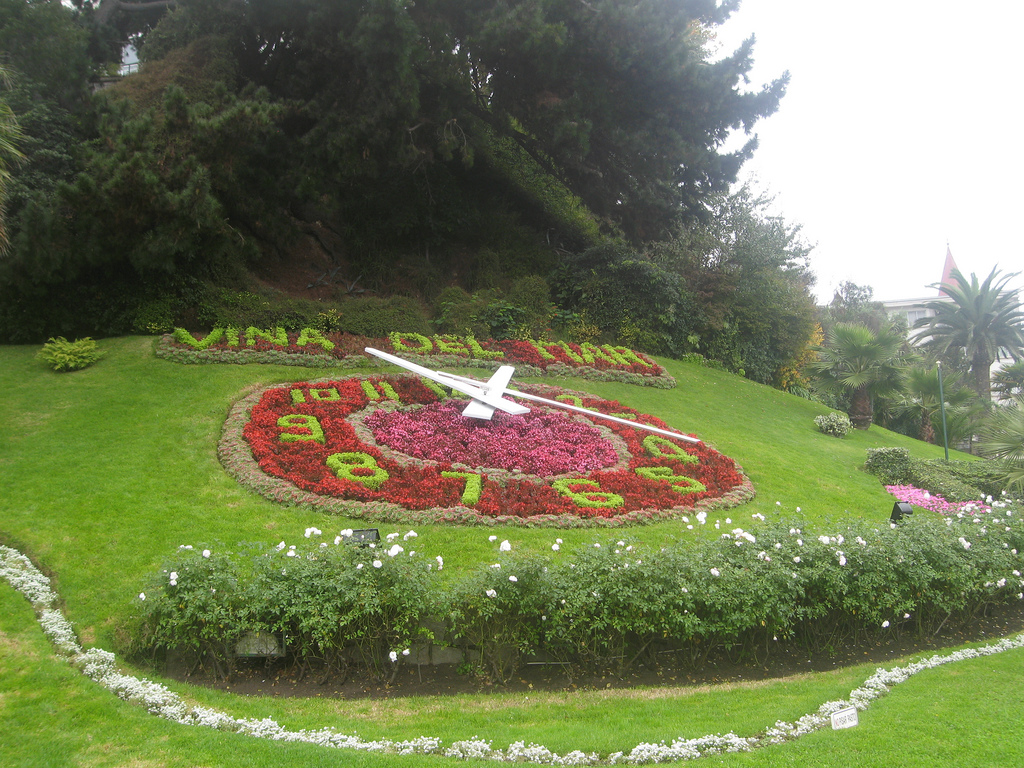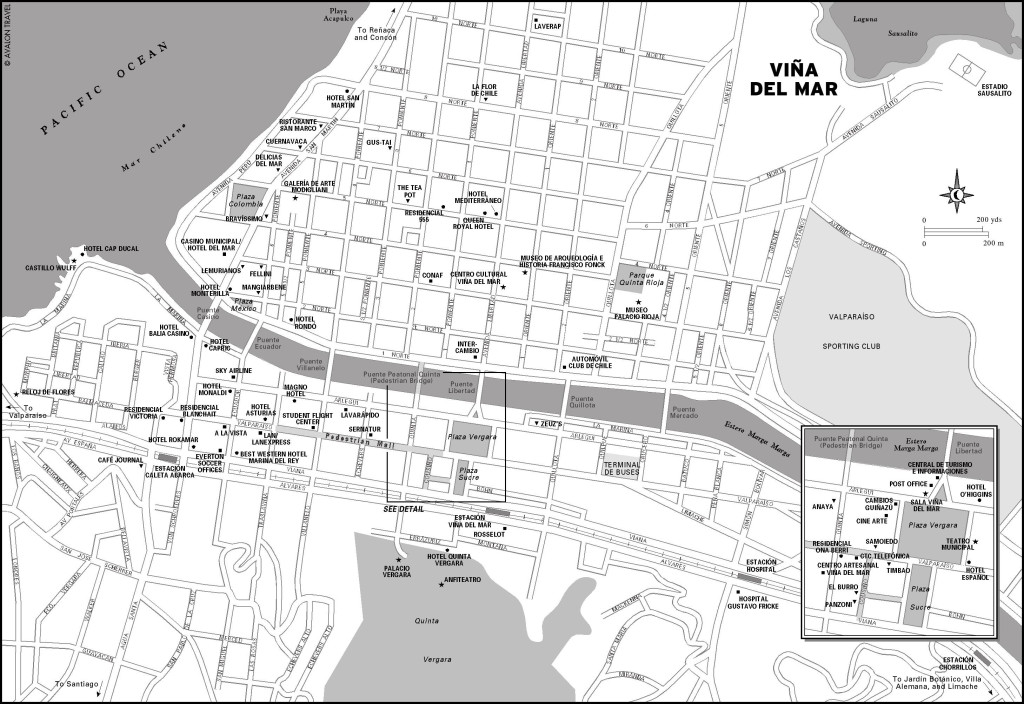
Viña del Mar’s signature Reloj de Flores or “Clock of Flowers.” Photo © John O’Connell, licensed Creative Commons Attribution.
Renowned for white-sand beaches that stretch north through the suburbs of Reñaca and Concón, Viña del Mar is also Chile’s Ciudad Jardín (Garden City) for its Mediterranean cityscapes—one of its signature symbols is the Reloj de Flores, the “Clock of Flowers” at the Avenida Marina approach from Valparaíso.In the immediate post-independence times, though, today’s Viña del Mar was puro campo, a bucolic countryside that was part of the Carrera family’s Hacienda Las Siete Hermanas. One of Chile’s founding families, the Carreras sold the hacienda to the Alvares-Vergara family, who, as the Santiago–Valparaíso railroad increased land values, sold off parts of the property to wealthy Valparaíso businessmen, marking a transition from semi-rurality to elegant residential suburb and beach resort.
Throughout the latter half of the 20th century, though, Viña del Mar became a more democratic destination and even began to pull Argentine tourists from across the Andes—despite constant fogs, cool sea breezes, and cold Pacific currents that can make entering the water a forbidding experience. Once Chile’s prestige beach resort, Viña del Mar has lost ground to competitors such as La Serena (whose seaside climate is only slightly milder) but still gets hordes of weekend and summer beachgoers from metropolitan Santiago.

Viña Del Mar
Viña del Mar (population about 300,000) is 120 kilometers northwest of Santiago via Ruta 68 and about 10 kilometers north of Valparaíso via Avenida España, which hugs the shoreline. The Estero Marga Marga, a potentially stunning riverbank asset that’s been turned into a disgraceful backhoe parking lot crossed by a series of parallel bridges, divides the city’s northern and southern sectors. There is an ambitious plan to transform the westernmost Marga Marga into a commercial marina, but no sign of progress.
To the south, between the estuary and the railroad tracks, the commercial district is centered on Plaza Vergara, with many of the city’s traditional mansions beyond the tracks, including the fabled grounds of the Quinta Vergara; to the north, Avenida Libertad crosses the river to a more regular residential grid, where most streets and avenues bear numbers rather than names. They are further distinguished by direction: Norte (north), Oriente (east), or Poniente (west). At the district’s western edge, paralleling the beach, Avenida San Martín and surrounding side streets are home to most of Viña del Mar’s better restaurants and nightlife venues.
On several blocks of Avenida Valparaíso, the main commercial thoroughfare, sidewalks have been widened and retiled to create a more pedestrian-friendly environment. Terraces of luxury condos cover the beachfront hillsides of Reñaca, politically part of Viña del Mar but with its own distinct identity.
Viña del Mar is less spontaneously engaging than Valparaíso—there are fewer real surprises as you walk around town—but there are scattered historical monuments and museums. One entertaining way to orient yourself is to hire one of Plaza Vergara’s elegant victorias (horse-drawn carriages), for about US$20 per hour.
Viña del Mar’s municipal Centro de Informaciones Turísticas (Arlegui 715, tel. 032/2185710, 9 a.m.–9 p.m. weekdays, 10 a.m.–9 p.m. weekends and holidays Jan.–Feb.; 9 a.m.–2 p.m. and 3–7 p.m. weekdays, 4–7 p.m. on weekends and holidays Mar.–Dec.) occupies new offices on the south side of Hotel O’Higgins. Its monthly newsletter, Todo Viña, is an exhaustive calendar of events and entertainment in Viña del Mar, Valparaíso, and surrounding suburbs; it also offers a free city map.
At the bus station, there’s a privately run Oficina de Informaciones (Av. Valparaíso 1055, tel. 032/2752000, 9:30 a.m.–5 p.m. daily, longer summer hours).
The Automóvil Club de Chile (Acchi, 1 Norte 901, tel. 032/2689505) helps motorists.
The regional office of Corporación Nacional Forestal (Conaf, 3 Norte 541, tel. 032/2970108) has information on Parque Nacional La Campana and other protected areas.
BancoEstado (Arlegui 409) has an ATM, but there are many others. Guiñazú Cambios (Arlegui 686) is a foreign exchange house.
Correos de Chile (Plaza Latorre 32) is the post office. Cyber Paris (Avenida Libertad 45) has both long-distance telephone and Internet connections.
FastClean (Libertad 902, tel. 032/2695975) handles the washing.
Hospital Gustavo Fricke (Alvares 1532, tel. 032/2680041), south of the tracks, has its own Merval station.
Excerpted from the Fourth Edition of Moon Chile.